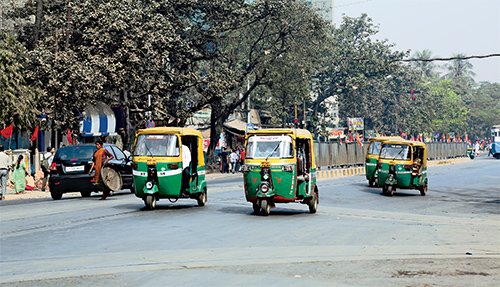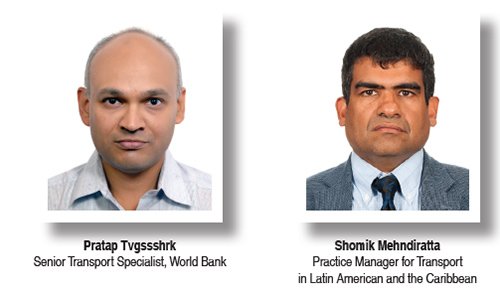India’s roads claim 150,000 lives a year, with more than 500,000 seriously injured, and the figures have been steadily increasing for the last 25 years, according to Government estimates. But India is now seizing a unique opportunity to reverse this trend. As part of a national push for modernizing and improving the country’s network, tens of thousands of kilometres of roads are being constructed by the Ministry of Road Transport and Highways and state agencies. And they are committed to make road safety a central part of this effort.
Among the several government initiatives being implemented, a key one is the Road Safety Audit.
 Until 2014 road safety audits were rare and not required in India. A World Bank-financed initiative—the National Highways Interconnectivity Improvement Project (NHIIP)—helped introduce systematic use of design-stage road safety audits across India’s road system, starting with the project’s 1,100 km of roads.
Until 2014 road safety audits were rare and not required in India. A World Bank-financed initiative—the National Highways Interconnectivity Improvement Project (NHIIP)—helped introduce systematic use of design-stage road safety audits across India’s road system, starting with the project’s 1,100 km of roads.
Among the changes made possible under the audits were geometric design improvements allowing for better geometry and sight distance, the incorporation of speed calming measures, pedestrian facilities, junction improvements, crash barriers, signs and markings and more. All these road safety features increased costs by less than five percent.
However, to mainstream and sustain such efforts, a multi-pronged approach was required:
 First in 2014, MoRTH mandated and issued guidelines to its agencies that all road projects costing more than $800,000 will have to mandatorily undergo road safety audits. Subsequently, MoRTH updated and issued detailed guidelines based on experience and feedback.
First in 2014, MoRTH mandated and issued guidelines to its agencies that all road projects costing more than $800,000 will have to mandatorily undergo road safety audits. Subsequently, MoRTH updated and issued detailed guidelines based on experience and feedback.- Complemented with standardized procedures in the form of a Road Safety Audit Manual to guide and standardize the audit process. This manual thoroughly covered the procedures to carry out road safety audits at the design, construction, and operation stages, with illustrative examples. The Indian Roads Congress (IRC) deliberated this draft in its committees and came up with a final product which is now under print, and will apply for all the types of roads in the country’s network: National Highways, State Highways, District and Village Roads, and Rural Roads.
- A sustained capacity building effort is also being undertaken by MoRTH to build capacity of its agencies and the state Public Works Departments in road safety. It has roped in many educational institutes and individual experts through a specialized training agency to conduct free-of-cost training on road safety and road safety audits to all the staff involved in preparation and implementation of projects. So far, about 2,000 staff have been trained and very soon training of consultants and contractors’ staff will also start.
 During this time MoRTH has also been exploring contracting innovations that transferred much higher ownership and accountability to contractors. MoRTH made road safety an integral element of contracts by drafting bidding documents that required the contractors to (a) employ a Safety Consultant and conduct road safety audit, (b) deploy qualified safety staff in its team for the entire construction period, (c) prepare a traffic management and safety plan, (d) develop a monitoring and evaluation mechanism, and (e) agree to a penalty structure including stringent measures such as suspension of works. All these measures are helping in bringing in ‘safety culture’ in implementation of projects. Finally, the MoRTH has started procurement of a consultant firm to develop and implement an Integrated Road Accident Database Management System. This will be a web-based system compatible with mobile phone operating systems and with proper linkages to other systems maintained by the Transport, Police and Health departments, and use Artificial Intelligence for predictive modelling.
During this time MoRTH has also been exploring contracting innovations that transferred much higher ownership and accountability to contractors. MoRTH made road safety an integral element of contracts by drafting bidding documents that required the contractors to (a) employ a Safety Consultant and conduct road safety audit, (b) deploy qualified safety staff in its team for the entire construction period, (c) prepare a traffic management and safety plan, (d) develop a monitoring and evaluation mechanism, and (e) agree to a penalty structure including stringent measures such as suspension of works. All these measures are helping in bringing in ‘safety culture’ in implementation of projects. Finally, the MoRTH has started procurement of a consultant firm to develop and implement an Integrated Road Accident Database Management System. This will be a web-based system compatible with mobile phone operating systems and with proper linkages to other systems maintained by the Transport, Police and Health departments, and use Artificial Intelligence for predictive modelling.
India is taking bold and innovative steps to tackling its road safety challenge. The proof of the pudding will be in making full use of the audits for the continuous evaluation and taking of corrective steps to keep India’s roads safe now and in the future.
 TrafficInfraTech Magazine Linking People Places & Progress
TrafficInfraTech Magazine Linking People Places & Progress


